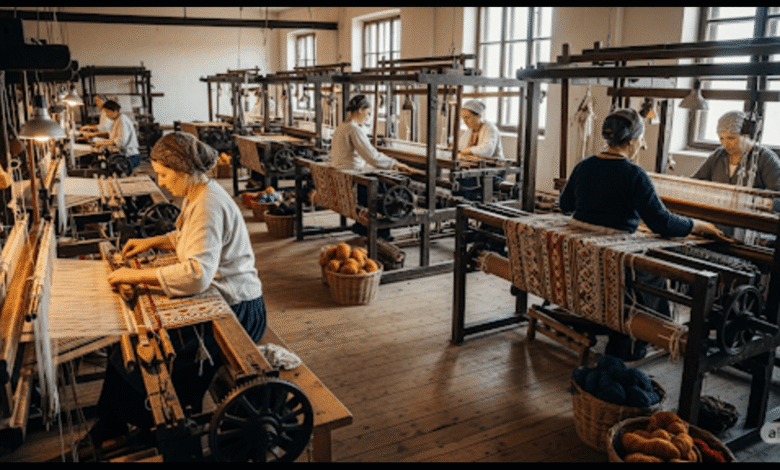Looms: The Timeless Art and Innovation of Weaving

Looms have been a cornerstone of human creativity and industry for thousands of years. From ancient civilizations to modern textile factories, looms have helped shape fashion, function, and the very fabric of our culture—literally.
Whether you’re curious about traditional hand looms, industrial weaving machines, or DIY weaving kits, this article will guide you through what looms are, how they work, their types, uses, and much more.
What Is a Loom?
A loom is a device used to weave threads or yarns into fabric. It holds the warp threads (longitudinal) tightly while allowing the weft thread (horizontal) to be interwoven to create textiles. While looms have evolved significantly over the centuries—from simple wooden frames to computer-controlled machines—the core principle remains the same: turning thread into fabric.
A Brief History of Looms
The concept of the loom dates back to prehistoric times, with early forms being used in Egypt, Mesopotamia, and China as early as 5000 BC. Over time, looms advanced in complexity and efficiency. Key innovations include:
- The Drawloom in ancient China, which allowed complex patterns.
- The Flying Shuttle (1733) by John Kay, revolutionizing weaving speed.
- The Jacquard Loom (1804), which introduced programmable weaving, using punch cards.
- Modern Power Looms, which are now digitally controlled and dominate the textile industry.
Types of Looms
Depending on the user and the purpose, there are various kinds of looms:
1. Hand Loom
Traditional and manually operated, hand looms are used by artisans for high-quality, often artistic weaving. They require skill and patience and are common in regions known for handmade textiles, such as India or Peru.
2. Frame Loom
Ideal for beginners and hobbyists, frame loomed are simple and portable. They’re perfect for DIY wall hangings, scarves, or experimenting with textures and patterns.
3. Table Loom
These are small, portable looms that sit on a table. They offer more weaving control and are great for education and practice.
4. Rigid Heddle Loom
A popular choice among hobbyists, these looms are relatively easy to use and produce good-sized fabric pieces.
5. Tapestry Loom
Used for making pictorial designs or wall art, tapestry looms allow intricate patterns with various yarn thicknesses.
6. Power Loom
Automated and industrial, these machines produce massive quantities of fabric in commercial textile mills.
What Are Looms Used For?
Looms are used to create a variety of woven textiles, including:
- Clothing and fashion fabric
- Rugs and carpets
- Wall hangings and tapestries
- Towels, linens, and blankets
- Upholstery fabric
- Art and decorative items
In many cultures, loom weaving is also tied to heritage, with traditional designs being passed down through generations.
Benefits of Weaving with Looms
- Creativity: Weaving allows for artistic expression in texture, color, and design.
- Therapeutic Value: Many find weaving relaxing and meditative.
- Skill-Building: It teaches patience, focus, and fine motor coordination.
- Sustainability: Handmade woven items promote slow fashion and reduce waste.
FAQs About Looms
Q1: What is the best loom for beginners?
A: A frame loom or rigid heddle loom is ideal for beginners. They are affordable, easy to use, and great for learning the basics of weaving.
Q2: Are hand looms still used today?
A: Yes, hand looms are still widely used, especially in countries like India, Nepal, and Morocco. They are key in artisan and traditional textile production, often valued for their unique, high-quality output.
Q3: What’s the difference between knitting and weaving?
A: Weaving involves interlacing two sets of threads (warp and weft), while knitting uses a single thread looped continuously. Woven fabrics are generally tighter and more structured.
Q4: Can I make a loom at home?
A: Absolutely! DIY looms can be made from cardboard, wood, or even an old picture frame. Many crafters start with homemade looms before investing in professional ones.
Q5: What materials can be woven on a loom?
A: Common materials include cotton, wool, linen, silk, and synthetic yarns. Some artistic weavers also use ribbons, beads, fabric strips, or even recycled plastic.
Q6: How long does it take to make something on a loom?
A: It depends on the size and complexity of the project. A small wall hanging may take a few hours, while a rug or shawl could take days or weeks.
Q7: Are loom-woven fabrics more durable?
A: Typically, yes. Woven fabrics have interlaced threads that provide structure and durability, making them suitable for clothing, upholstery, and more.
Final Thoughts
Looms are a beautiful blend of tradition, technique, and creativity. Whether you’re fascinated by the history of textile production, eager to try weaving as a hobby, or simply curious about how your clothes are made, learning about looms opens up a world of inspiration.
With their centuries-old legacy and modern adaptations, looms continue to weave stories—not just through fabric, but through culture, artistry, and innovation.
So, whether you’re dreaming of starting your own weaving journey or just admiring the intricate beauty of handmade textiles, remember: the loom is where thread becomes art.




